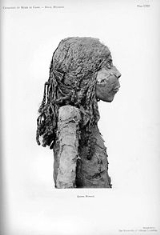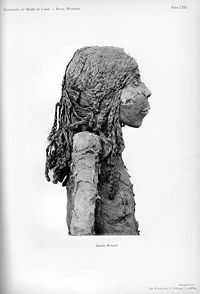
Herihor
Encyclopedia

Egypt
Egypt , officially the Arab Republic of Egypt, Arabic: , is a country mainly in North Africa, with the Sinai Peninsula forming a land bridge in Southwest Asia. Egypt is thus a transcontinental country, and a major power in Africa, the Mediterranean Basin, the Middle East and the Muslim world...
ian army officer and High Priest of Amun at Thebes
High Priests of Amun at Thebes
While not regarded as a dynasty, the High Priests of Amun at Thebes were nevertheless of such power and influence that they were effectively the rulers of Upper Egypt from 1080 to c.943 BC, after this period their influence declined...
(1080 BC to 1074 BC) during the reign of Pharaoh
Pharaoh
Pharaoh is a title used in many modern discussions of the ancient Egyptian rulers of all periods. The title originates in the term "pr-aa" which means "great house" and describes the royal palace...
Ramesses XI
Ramesses XI
Ramesses XI reigned from 1107 BC to 1078 BC or 1077 BC and was the tenth and final king of the Twentieth dynasty of Egypt. He ruled Egypt for at least 29 years although some Egyptologists think he could have ruled for as long as 30...
although Karl Jansen Winkeln has argued that Piankh preceded Herihor as High Priest at Thebes and that Herihor outlived Ramesses XI before being succeeded in this office by Pinedjem I
Pinedjem I
Pinedjem I was the High Priest of Amun at Thebes in Ancient Egypt from 1070 BC to 1032 BC and the de facto ruler of the south of the country from 1054 BC. He was the son of the High Priest Piankh. However, many Egyptologists today believe that the succession in the Amun priesthood actually ran from...
, Piankh's son based on the decoration program of the Temple of Khonsu at Karnak which depicts the chief priests Herihor and then Pinedjem I, serving in this office but never Piankh. If true, Herihor would have served in office as chief priest--after succeeding Piankh--for longer than just 6 years as is traditionally believed.
Life
While his origins are unknown, it is thought that his parents were Libyans. Recent studies by Karl Jansen-Winkeln in ZAS 119 (1992) suggest that Piankh-originally thought to be Herihor's successor-was actually Herihor's predecessor.Herihor advanced through the ranks of the military during the reign of Ramesses XI and was integral to restoring order by ousting Pinehesy
Pinehesy
Pinehesy, Panehesy or Panehasy, depending on different transliteration was Viceroy of Kush during the reign of Ramesses XI, the last king of the Egyptian 20th Dynasty....
, viceroy of Nubia
Nubia
Nubia is a region along the Nile river, which is located in northern Sudan and southern Egypt.There were a number of small Nubian kingdoms throughout the Middle Ages, the last of which collapsed in 1504, when Nubia became divided between Egypt and the Sennar sultanate resulting in the Arabization...
, from Thebes
Thebes, Egypt
Thebes is the Greek name for a city in Ancient Egypt located about 800 km south of the Mediterranean, on the east bank of the river Nile within the modern city of Luxor. The Theban Necropolis is situated nearby on the west bank of the Nile.-History:...
. His wife Nodjmet, may have been Ramesses XI's daughter--and perhaps even Piankh's wife if Piankh was his predecessor as Karl Jansen Winkeln today hypothesizes. At the decoration of the hypostyle hall walls of the temple of Khonsu at Karnak, Herihor served several years under king Ramesses XI since he is shown obediently performing his duties as chief priest under this sovereign. But he assumed more and more titles, from high priest to vizier
Vizier (Ancient Egypt)
The vizier was the highest official in Ancient Egypt to serve the king, or pharaoh during the Old, Middle, and New Kingdoms. Vizier is the generally accepted rendering of ancient Egyptian tjati, tjaty etc, among Egyptologists...
, before finally openly taking the royal title at Thebes even if he still nominally recognised the authority of Ramesses XI, the actual king of Egypt although it is disputed today if this 'royal phase' of Herihor's career begam during or after Ramesses XI's lifetime.
Herihor never really held power outside the environs of Thebes, and Ramesses XI may have outlived him by two years although Jansen-Winkeln argues that Ramesses XI actually died first and only then did Herihor finally assume some form of royal status at Thebes and openly adopted royal titles--but only in a "half-hearted" manner according to Arno Egberts who has adopted Jansen Winkeln's views here. Herihor's usurpation of royal privileges is observed "in the decoration of the court of the Khonsu temple" but his royal datelines "betray nothing of the royal status he enjoyed according to the contemporaray scenes and inscriptions of the court of the Khonsu temple." While both Herihor and his wife Nodjmet were given royal cartouches in inscriptions on their funerary equipment, their 'kingship' was limited to a few relatively restricted areas of Thebes whereas Ramesses XI's name was still recorded in official administrative documents throughout the country. Under the Wehem Mesut era, the Theban high priest--Herihor--and Ramesses XI quietly agreed to accept the new political situation where the High Priest was unofficially as powerful as Pharaoh. The report of Wenamun
Story of Wenamun
The Story of Wenamun is a literary text written in hieratic in the Late Egyptian language...
(also known as Wen-Amon) was made in Year 5 of Herihor and Herihor is mentioned in several Year 5 and Year 6 mummy linen graffitos.
The de facto split between Ramesses XI and his 21st Dynasty successors with the High Priests of Amun at Thebes
Thebes, Egypt
Thebes is the Greek name for a city in Ancient Egypt located about 800 km south of the Mediterranean, on the east bank of the river Nile within the modern city of Luxor. The Theban Necropolis is situated nearby on the west bank of the Nile.-History:...
(referred to in Ancient Egyptian as Wehem Mesut) or 'Renaissance' resulted in the unofficial political division of Egypt between Upper Egypt and Lower Egypt with the Tanite based kings ruling Lower Egypt from Tanis
Tanis, Egypt
Tanis , the Greek name of ancient Djanet , is a city in the north-eastern Nile delta of Egypt. It is located on the Tanitic branch of the Nile which has long since silted up.-History:...
. This division was not completely ended until the country was finally reunited with the accession of the Libya
Libya
Libya is an African country in the Maghreb region of North Africa bordered by the Mediterranean Sea to the north, Egypt to the east, Sudan to the southeast, Chad and Niger to the south, and Algeria and Tunisia to the west....
n Dynasty 22 king Shoshenq I
Shoshenq I
Hedjkheperre Setepenre Shoshenq I , , also known as Sheshonk or Sheshonq I , was a Meshwesh Berber king of Egypt—of Libyan ancestry—and the founder of the Twenty-second Dynasty...
in 943 BC; Shoshenq was able to appoint his son Iuput to be the new High Priest of Amun at Thebes and thus exercise authority over all of the country.
Traditional Ethiopian kinglists name Herihor, and his successors through Pinudjem II, among the rulers of Saba in the Semitic Agazyan Ethiopian dynasty, and he is considered to have ruled Ethiopia for 16 years in addition to being de facto ruler in Egypt. According to Ethiopian historian Tekletsadiq Mekuria, Herihor's father was the former High Priest Amenhotep
Amenhotep (High Priest of Amun)
Amenhotep was High Priest of Amun at the end of the 20th Dynasty. He served under Ramesses IX-Ramesses XI.Amenhotep also held the tiles: vizier, great confidante of his master, first prophet of Amun-resonther....
, and his mother was a daughter of Ramses IV.
Further reading
- Kees, Hermann. Die Hohenpriester des Amun von Karnak von Herihor bis zum Ende der Äthiopenzeit (1964). Leiden: E. J. Brill

